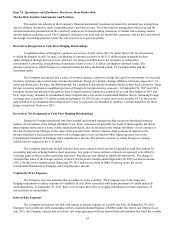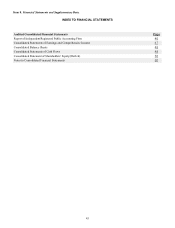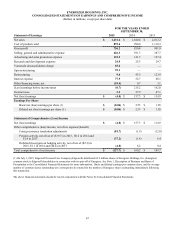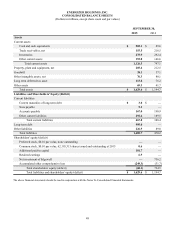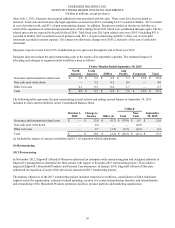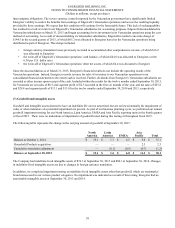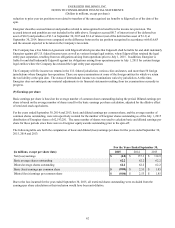Energizer 2015 Annual Report Download - page 56
Download and view the complete annual report
Please find page 56 of the 2015 Energizer annual report below. You can navigate through the pages in the report by either clicking on the pages listed below, or by using the keyword search tool below to find specific information within the annual report.ENERGIZER HOLDINGS, INC.
NOTES TO CONSOLIDATED FINANCIAL STATEMENTS
(Dollars in millions, except per share)
52
Cash and Cash Equivalents – Cash and cash equivalents consist of cash on hand and marketable securities with original
maturities of three months or less. At September 30, 2015, Energizer had $502.1 in available cash, 95% of which was outside of
the U.S. The Company has extensive operations, including a significant manufacturing footprint outside of the U.S. We
manage our worldwide cash requirements by reviewing available funds among the many subsidiaries through which we
conduct our business and the cost effectiveness with which those funds can be accessed. The repatriation of cash balances from
certain of our subsidiaries could have adverse tax consequences or be subject to regulatory capital requirements; however, those
balances are generally available without legal restrictions to fund ordinary business operations. U.S. income taxes have not
been provided on a significant portion of undistributed earnings of international subsidiaries. Our intention is to reinvest these
earnings indefinitely.
Prior to the spin-off, cash was managed centrally with net earnings reinvested locally and working capital requirements met
from existing liquid funds. Accordingly, the cash and cash equivalents held by Edgewell at the corporate level was not
attributed to Energizer and only cash amounts specifically attributable to Energizer legal entities are reflected as of September
30, 2014.
Foreign Currency Translation – Financial statements of foreign operations where the local currency is the functional currency
are translated using end-of-period exchange rates for assets and liabilities and average exchange rates during the period for
results of operations. Related translation adjustments are reported as a component within accumulated other comprehensive
income in the equity section of the Consolidated Balance Sheets, except as noted in Note 6, Venezuela.
Financial Instruments and Derivative Securities – Energizer uses financial instruments, from time to time, in the management
of foreign currency, interest rate risk and commodity price risks that are inherent to its business operations. Such instruments
are not held or issued for trading purposes.
Every derivative instrument (including certain derivative instruments embedded in other contracts) is required to be recorded on
the balance sheet at fair value as either an asset or liability. Changes in fair value of recorded derivatives are required to be
recognized in earnings unless specific hedge accounting criteria are met.
Foreign exchange instruments, including currency forwards, are used primarily to reduce cash transaction exposures and to
manage other translation exposures. Foreign exchange instruments used are selected based on their risk reduction attributes,
costs and the related market conditions. The Company has designated certain foreign currency contracts as cash flow hedges for
accounting purposes as of September 30, 2015 and 2014.
The Company has interest rate risk with respect to interest expense on variable rate debt. The Company is party to an interest
rate swap agreement with one major financial institution that fixes the variable benchmark component (LIBOR) on $200.0 of
the Company's variable rate debt at September 30, 2015.
Energizer uses raw materials that are subject to price volatility. The Company may use hedging instruments to reduce exposure
to variability in cash flows associated with future purchases of commodities. There were no outstanding derivative contracts for
the future purchases of commodities as of September 30, 2015.
Cash Flow Presentation – The Consolidated Statements of Cash Flows are prepared using the indirect method, which
reconciles net earnings to cash flow from operating activities. The reconciliation adjustments include the removal of timing
differences between the occurrence of operating receipts and payments and their recognition in net earnings. The adjustments
also remove cash flows arising from investing and financing activities, which are presented separately from operating activities.
Cash flows from foreign currency transactions and operations are translated at an average exchange rate for the period. Cash
flows from hedging activities are included in the same category as the items being hedged, which is primarily operating
activities. Cash payments related to income taxes are classified as operating activities.
Trade Receivables, net – Trade receivables are stated at their net realizable value. The allowance for doubtful accounts reflects
the Company's best estimate of probable losses inherent in the receivables portfolio determined on the basis of historical
experience, specific allowances for known troubled accounts and other currently available information. Bad debt expense is
included in Selling, general and administrative expense (SG&A) in the Consolidated Statements of Earnings and
Comprehensive Income.



